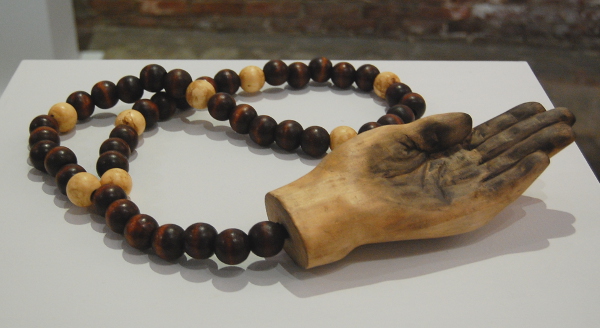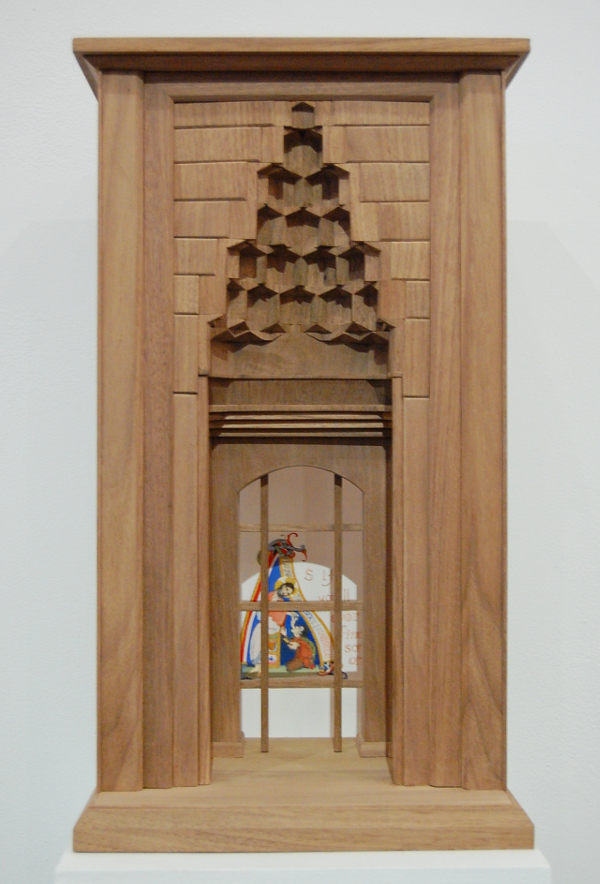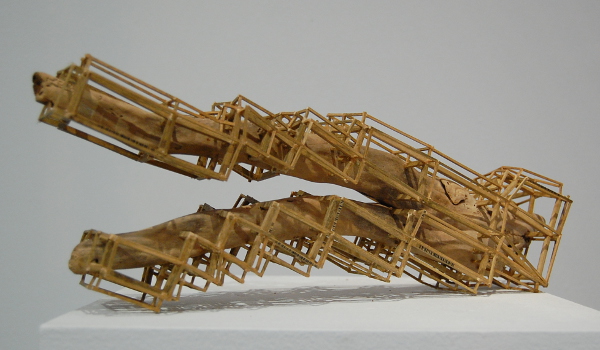
Philadelphia Sculpture Gym is a reliquary for contemporary wooden iconography
If the third time is the charm, then the Philadelphia Sculpture Gym‘s “Process: Wood III” show is surely the enchanted culmination of its two predecessors. This Knight Arts grantee acts as the reliquary for a number of artifacts, many of which seem to cast a spiritual slant on one of the most time-tested mediums. Even in the cases where these pieces are not overtly inspired by religion, they wield certain supernatural qualities that peg them as anomalies that skirt the expected or the definite.
Ramond Padron focuses on one of the evolutionary traits that undoubtedly propelled human beings from the savannah to become toolmaking masters of their environment: the hand. Outside of its scientific context and general manual dexterity, the hand has often served as a channel for religious rites, including praying or blessing gestures, stigmata markings, laying on of hands for healing purposes, and of course rosary and prayer bead meditation practices. Concerning the latter, Padron indeed attaches a string of polished dark and light-colored wooden beads to the cutoff wrist of the hauntingly realistic carved hand. Like an act of devotion to the working artist, “Thy Hand” is not only anatomically ideal, but also sooty and dirty on the upturned surface of the palm and fingers. Seen as a testament to the creative and conscientious, this rosary provides a delicately reflective vehicle for the troubled art maker.
Brian Van Camerik, “Algorithmic Romances: As If You’ll Find Anyone.”
Harnessing yet another medieval throwback, we find an altarpiece by Brian Van Camerik with a contemporary twist. A beautifully crafted window that comes to a geometric-Gothic peak looks in on an interior icon much like its centuries-old ancestors did, only this is where Camerik’s creation diverges. The figures inside bear much resemblance to a period depiction of Jesus, except the actual message here is one of digital relationships. “Algorithmic Romances: As If You’ll Find Anyone” is simultaneously entertaining and cynical, with the Christ figure’s robe bearing logos from such dating websites as OkCupid and Grindr. A scroll above the characters reads “Taking the cyber self from the corporeal” as the standing figure removes a tiny, nude man from the kneeling person’s open mouth. Seemingly admonishing online daters as overly optimistic, this piece certainly calls into question many aspects of 21st-century courtship by way of allegorical images from the Middle Ages.
Phil McGaughy, “Splitting Stick.”
Phil McGaughy’s structures are more pantheistic than Christian in origin, and pair natural wood with the angled additions of straight, machined materials. In “Splitting Stick” we find a forked branch of driftwood surrounded by a rectangular scaffolding of tiny square-shaped strips of basswood. “The Disagreement” finds two disjointed parts of a singular piece of wood similarly surrounded as if being reassembled. These artworks speak to the human tendency for organization and the often difficult or impossible task of bending nature to our whims. Like it or not, a broken stick will never be perfectly one again, and a forked branch will never be completely straight. If ingenuity is no consolation, then acceptance must be.
Shane Darwent, “Are we there yet?”
Least like anything else in the show, but very much worthy of attention is “Are we there yet?” by Shane Darwent. Three highway signs intersect with one another in a convoluted conversation revolving around transportation, place, journeys and their ultimate destinations. This piece is rather confusing, and the signs are largely unreadable in their present configuration. It is possible to read “Scenic Overlook” and “Sunset Point” through the jumble, but from the seat of a quick-moving vehicle, it would be next to futile. What is the role of signs if they can’t be read? Why doesn’t life come complete with signs that help us on our way, even if they are difficult to read? On second thought, who’s to say that it doesn’t? Formed from wood that now greatly resembles metal, these converging directions offer us little practical help, but plenty of existential fodder to reconcile.
From the philosophical to the natural, the meditative to the almost irreverent, the “Process: Wood III” show offers a sampling of relics from one of the most ubiquitous of all sculptural substances. There is no doubt that there are many messages contained therein, but in the end, the medium remains as the common ground. The exhibit will be on display through November 28th.
Philadelphia Sculpture Gym is located at 1834 Frankford Ave., Philadelphia; [email protected]; philadelphiasculpturegym.com.
Recent Content
-
Artsarticle ·
-
Artsarticle ·
-
Artsarticle ·




